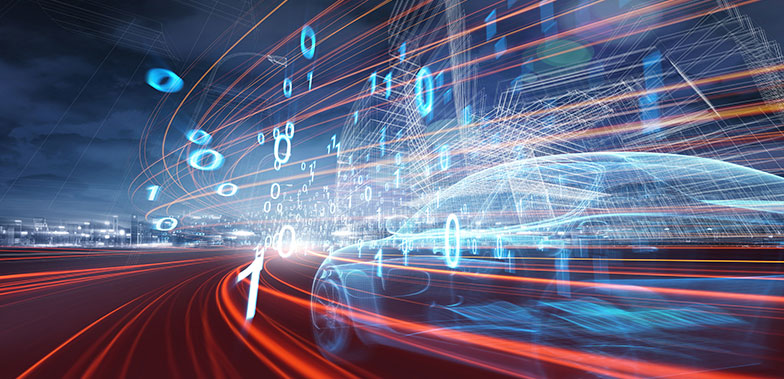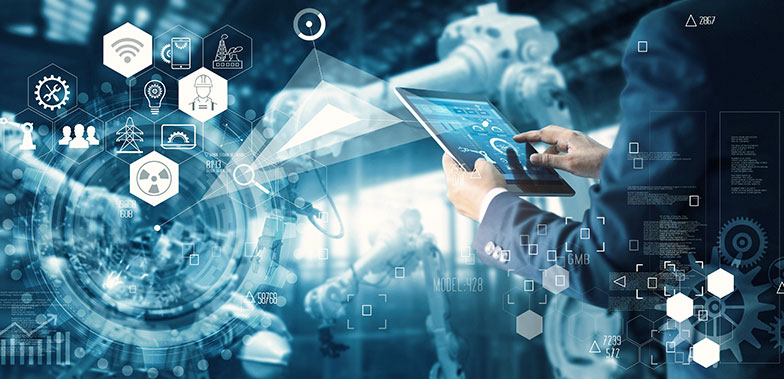5G is the fifth generation of mobile networks, following on from previous generations; 2G, 3G and 4G. 5G is set to offer much faster connection speeds than previous networks. Also, being more reliable with lower response times and greater capacity.
Called ‘the network of networks,’ it is due to unite many existing standards and cross different technologies and industries as an enabler of Industry 4.0.
5G operates in the same way, but uses higher radio frequencies that are less cluttered. This allows for it to carry more information at a much faster rate. These higher bands are called 'millimeter waves' (mmwaves). They were previously unused but have been opened up for licensing by regulators. They had been largely untouched by the public as the equipment to use them was largely inaccessible and expensive.
While higher bands are faster at carrying information, there can be problems with sending over large distances. They are easily blocked by physical objects such as trees and buildings. In order to circumvent this challenge, 5G will utilise multiple input and output antennae to boost signals and capacity across the wireless network.
The technology will also use smaller transmitters. Placed on buildings and street furniture, as opposed to using single stand-alone masts. Current estimates say that 5G will be able to support up to 1,000 more devices per metre than 4G.
5G technology will also be able to ‘slice’ a physical network into multiple virtual networks. This means that operators will be able to deliver the right slice of network, depending on how it is being used, and thereby better manage their networks. This means, for example, that an operator will be able use different slice capacities depending on importance. So, a single user streaming a video would use a different slice to a business, while simpler devices could be separated from more complex and demanding applications, such as controlling autonomous vehicles.
There are also plans to allow businesses to rent their own isolated and insulated network slice in order to separate them from competing Internet traffic.
The first nation to adopt on a large scale was South Korea, in April 2019, at which point there were some 224 operators in 88 countries around the world investing in the technology.
In South Korea, all the 5G carriers used Samsung, Ericsson and Nokia base stations and equipment, apart from one who used Huawei equipment. Of these suppliers, Samsung was the largest, having shipped 53,000 base stations from a total of 86,000 base stations installed in the country at the time.
There are currently nine companies that sell 5G radio hardware and systems for carriers. These are Altiostar, Cisco Systems, Datang Telecom, Ericsson, Huawei, Nokia, Qualcomm, Samsung and ZTE.
The most evident advantage of 5G networks over 4G is the speed of the network. However, there are also advantages relating to reduced latency – meaning faster response times as well as fast download speeds. This opens up a wealth of potential applications across industry due to improved operational efficiency.
Among the applications for 5G are superfast broadband with no need for landlines, 5G mobile telecommunications, the creation of smart factories, holographic technologies, televisions, remote healthcare, and driverless cars with 5G communication as well as car-to-car communication.
Many of these technological advances will be afforded by reduced latency, allowing 5G devices to respond to commands faster. Latency is the delay between a command being issued and the response being received. 3G has a 65 millisecond latency, advanced 4G is around 40 milliseconds of latency, while fixed broadband has a latency of between 10-20 milliseconds. By comparison, 5G is expected to operate with as little as 1 millisecond of latency, allowing mission-critical and Internet-of-Things applications to operate below the 4 millisecond target for an enchanced mobile broadband service.
The technology will also boast a greater capacity than previous network technologies. There will be access to a greater spectrum at higher frequencies, meaning that networks will be able to handle more high-demand applications simultaneously. This means that it could provide a fibre-like experience for fixed wireless applications, allowing those in areas that are difficult to reach to enjoy a greatly improved broadband service.
As mentioned above, the main selling-point of 5G relates to the speed of the network. With some claiming that peak speeds could eventually exceed 10Gps.
Initial speeds are set to be lower, with EE claiming peak speeds in excess of 1Gps, which is still on average between 100-150 Mbps faster than 4G speeds, which should equal around 130-240 Mbps in total. Meanwhile, the Three network is boasting high speeds of over 2Gps when they launch 5G.
However, there are real world factors to be taken into consideration, such as your distance from a base station and how many other people are connecting to the network at the same time. But, even under these circumstances, the user experienced data rate for downloads is still expected to be a minimum of 100Mbps – which is still much faster than with 4G.
Should 5G achieve the expected data speeds of 10 Gps, this will be 100 times faster than standard 4G. It will also be 30 times faster than advanced 4G standards such as LTE-A. However, even with more conservative estimates, it will easily outpace both 3G and 4G.
3G has average download speeds of 8Mbps and a maximum of 384Kbps, 4G has a 32.5MBps average download speed and a maximum of 100Mbps. 4G+ has a 42Mbps average and a maximum download speed of 300Mbps. While 5G, by comparison, has an average download speed of 130-240Mbps and a theoretical maximum of 1-10Gbps.
This means, for example, that it would take between 4 and 40 seconds to download a full HD film on 5G, as compared to over 7 minutes on 4G and over a day with 3G.
5G won’t be replacing 4G anytime soon. With some estimating that it could be decades before 4G disappears entirely.
This is very true in rural areas, where the cost of deployment could be high and the need for low latency isn’t so important.
The initial launches of 5G will depend on the existing 4G LTE infrastructure. Rollouts are expected to happen in the busiest places first.
For example, the UK will see 5G rolled out in 26 cities between 2019 and the end of 2020. London, Birmingham, Manchester, Edinburgh, Cardiff and Belfast set to be the first places to prepare for this new technology.
When it comes to mobile phones there will eventually be a need to upgrade to a 5G phone. Should you not have one of the few that are already on the market, such as the 5G LG V50 THINQ and the Xiaomi Mi Mix 3 5G smartphones.
However, with more equipment set to reach the market in the next 12 months and the time expected for a full rollout to occur, there is no real hurry to upgrade your existing handset just yet.

While 5G services have already started to be rolled out in countries like the US and South Korea, this is only in a limited form with limited coverage right now. Meanwhile, in the UK, 5G is still in its early stages. However, the technology rollout is set to continue through 2020, with more places being prepared.
So, at the moment, the world is not ready, but steps are being made to spread the technology.
5G looks set to revolutionise a wide range of products, services and industries. While the technology will offer performance increases for mobile technology (as mentioned above), there are a number of other applications that it looks set to impact.
Fixed wireless access will be one benefit for both domestic and business use as the fifth generation network will allow for online connectivity to rival fibre broadband, eliminating the need for a landline and bringing improved online access to hard-to-reach areas.
It will also provide a number of remote applications, with trials having already taken place with the NHS to remotely monitor important changes to a patient’s health. This remote functionality has also seen LG and Doosan remotely control an excavator on another continent.
5G is also being trialled with artificial intelligence and holographic technologies, while it is also being tested for the world’s first 5G television. Other entertainment-related uses include the deployment of the new networks to provide coverage at festivals and sporting events.
Transport is also set to be revolutionised, including developments in connected cars and the advent of autonomous transport (you can find out more about 5G and transport below).
Other ground-breaking uses of the technology include the creation of super smart factories which promise improved safety, more efficient manufacturing systems, and cost savings for both manufacturers and consumers (you can find out more about 5G and smart factories below).
These are just a few examples of how 5G could change everything from domestic life, transport and entertainment to business and manufacturing.
The first and most evident advantage is that it is faster and more reliable than 4G or 3G. While this means that you will be able to download a movie on your 5g home broadband in a matter of seconds, or stream a 4K film without buffering, there will also be an improvement in virtual and augmented reality applications. Due to 5G’s high capacity and low latency, advanced processing will be able to be handled remotely rather than relying on mobile devices and headsets for local handling.
This greater capacity will enable a growth of Internet of Things devices, with goods including refrigerators, lights, cars and even advertising hoardings being able to connect and communicate with one another. While Internet of Things devices are already taking hold in the market, 5G will improve the speed and capacity whereby almost every device could become connected and ‘smart.’
While these improvements are all advances on existing technologies, it should also enable the creation of completely new markets, including autonomous vehicles. The reduced latency afforded by 5G means that these vehicles will be able to connect to each other and the Internet without lag-times.
Autonomous vehicles are not the only technology that will critically use 5G, as remote surgery would also be made possible with doctors being able to control medical robots to perform procedures from anywhere in the world.
As previously mentioned, there has already been a successful trial of an excavator being controlled across continents, but 5G looks set to transform the world of industry through the ability to monitor and control robots, drones and entire factories in real time and with a greater degree of connectivity.

While the Internet of Things is already being used in a number of applications, it is in the realm of transport where it will likely have the biggest effect when coupled with the new network.
There will certainly be applications for aerospace, such as improved sharing of data between owners, managing ancillary systems on aircraft, bolstering safety and maintenance operations, processing data streams in near real time and, of course, providing improved in-flight entertainment and WiFi service to passengers, while also gathering information about passengers to improve customer experience.
However, it is in automotive that 5G could be a genuine game-changer with the advancement of the connected and autonomous car. Not to be confused with driverless cars, the connected car is one that is equipped with Internet access and often a wireless local area network. The connected car has been in operation for some time, with electronic systems put in place to aid driving through ABS and power steering, control functions such as the windscreen wipers or lights, and to manage entertainment and communications systems. More recently, advanced driver assistance systems such as adaptive cruise control or parking assistance, navigation telematics, vehicle monitoring and hands-free calling have all come into play.
All of these systems require the ability to communicate with each other in real time, with current high-end cars already exchanging thousands of signals through around 70 electronic control units. These networks have varying transmission speeds depending on the criticality of the data, so, for example, airbag deployment is far more important than the air-conditioning in a vehicle at the time of an accident.
These systems generate data that is used for services such as predictive vehicle maintenance, fleet management and tracking, allowing manufacturers to improve their products.
In-vehicle communications are just part of the picture as next-generation communications should allow vehicle-to-vehicle communication. This will let vehicles communicate with each other to share information on speed and location so that drivers can be more aware of what is happening around them and can adapt their driving accordingly.
Further to this, vehicles could connect to everything around them, from other vehicles to road infrastructure such as traffic lights and even the roads themselves. This data could enable traffic lights to react to traffic flow to reduce congestion, roads in need of repair could be easily identified and the use of this technology could finally herald fully autonomous vehicles. Meanwhile, connectivity of road infrastructure can help monitor traffic flow and raise alerts for potential issues such as debris on the road.
While there are challenges around cost and security, network connectivity between vehicles and the road infrastructure would allow vast amounts of data to be exchanged in real time to make fully autonomous transport a reality.

A white paper, published by HMS Labs, has concluded that 5G will revolutionise production processes on the factory floor. It is believed that the technology will lead to safer and more efficient manufacturing systems with greater flexibility.
This new smart factory model will enable more automation, which will not only lower costs but should also improve product quality by eliminating the scope for human error. These smart factories will also be able to offer flexibility around customised products to meet demand quickly, efficiently, and cost-effectively. The white paper contends that all of this will be made possible by the reliability, scalability and performance offered by 5G.
5G will allow for the automation of logistics, material handling and factory automation via wireless technology and machine-to-machine communication. This communication, coupled with the increased automation afforded by 5G, would allow everything from material deliveries, through production and warehousing and the delivery of finished products to be controlled and monitored remotely. However, not all factory applications will necessarily benefit, as HMS’ white paper noted, “The only area not suitable for 5G within industrial production is motion control with sub-millisecond cycle time requirements.”
While the consumer benefits of faster, reliable connection and lower latency are evident, 5G will also deliver some genuine benefits for business.
5G will offer improved remote working possibilities for employees, in turn saving time and becoming more productive as there will be less need for travel.
Network slicing will also allow companies to have their own dedicated networks to suit their specific needs, while the improved speed and latency will have a positive effect on operational efficiency and thereby productivity.
Rural communities will also be better connected, allowing more opportunities for businesses in these areas.
5G could also create brand new opportunities for products and industries that aren’t possible with 4G, with Qualcomm estimating that 5G could see the creation of 22 million jobs and the production of £8.5 trillion of goods and services by 2035. These estimates are backed up by Barclays Corporate Banking who believe that 5G could add £15.7 billion per year to the UK economy by 2025. However, these are just estimates right now as it is impossible to know exactly how this revolutionary new technology will be used to create services and applications that don’t exist at the moment.
Aside from new technologies, 5G should also offer plenty of productivity savings. A March 2018 report from O2 forecasts that 5G will provide the UK with £6 billion of productivity savings per year, while consumers will save £450 per year through the reduction in food prices, council and fuel bills as a result of smart products, smart grids and autonomous vehicles.
Elsewhere, the use of technologies like smart bins and lighting is estimated to save councils £2.8 billion per year, while the NHS could see 1.1 million GP hours freed up as a result of 5G enabled remote health services.
While 5G is not quite ready for use around the world, moves are being made to make this a reality. Once the technology is fully rolled out, it is clear that it could dramatically change the way we both work and live.